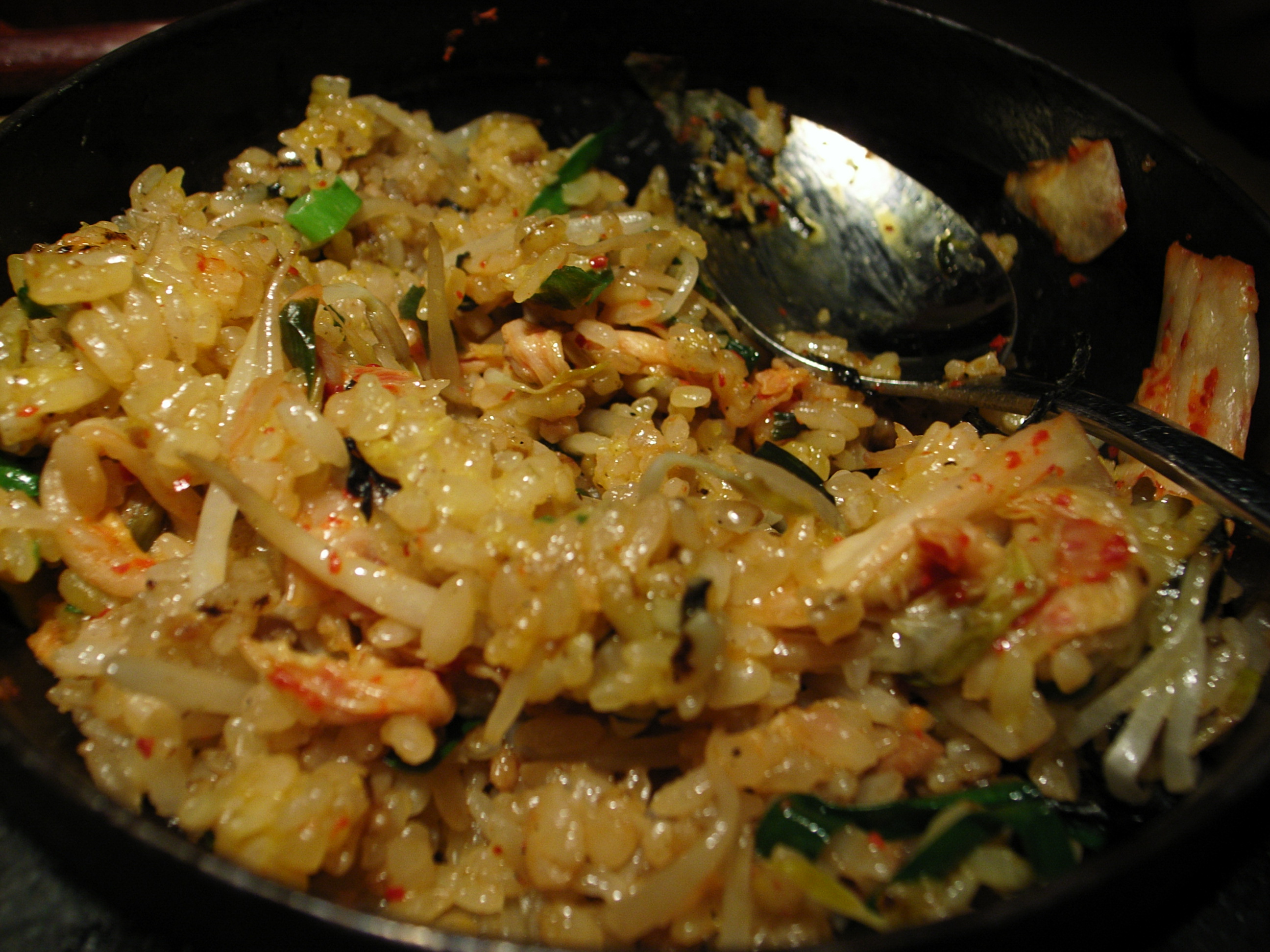- Kimchi bokkeumbap
hangul=김치 볶음밥
rr=gimchi bokkeumbap
mr=kimch'i pokkŭmpap"Kimchi bokkeumbap" (pronounced|kimʨʰi pokɯmpap) is a variety of "bokkeumbap" (
Hangul : 볶음밥,fried rice dishes), a popular dish inSouth Korea . Its name literally translates into "stir-fried rice made withkimchi ". "Kimchi bokkeumbap" is made primarily with kimchi andrice , along with other available ingredients such as diced vegetables or meats.Ingredients
Leftover rice and/or over-ripened kimchi as ingredients are usually preferred in preparing "kimchi bokkeumbap". cite web|title=Korean Food: Stir-fried Dishes |url=http://www.lifeinkorea.com/food/Food.cfm?Subject=stirfry |publisher=Life in Korea, Inc |language=English |accessdate=2008-04-02|] Over-ripened kimchi can also be used for cooking "
kimchi jjigae ".cite web|title=Kimchi Fried Rice |url=http://www.trifood.com/kimchibokumbop.html |publisher=TriFood.com |language=English|accessdate=2008-04-02|] Indeed, well-fermented kimchi and chilled rice can produce a flavor of greater richness as opposed to freshly made kimchi and rice. In preliminary preparation, as surplus "kimchiso" (hangul : 김치소, kimchi filling, mostly shreddeddaikon ,green onion s andjeotgal , fermented and salted seafood) taken out from kimchi, squeezed to discard itsbrine . Without completing the process, the resultant dish can be mushy in texture.Along with kimchi and rice, kimchi bokkeumbap can contain many kinds of ingredients.
Pork is preferred, however,beef ,chicken ,bacon ,ham , or spam can be used. Instead of meat, canned tuna,shrimp , ormushroom s can be used as a replacement, in the case the ingredient's name may be prefixed to the dish's name such as "beoseot kimchi bokkeumbap" (hangul : 버섯김치볶음밥, literally "mushroom kimchi bokkeumbap"). Meat ingredients are chopped into the dish together withvegetable s such asonion ,carrot orzucchini . However, ingredients depend on personal preference and occasion. A small amount of mincedgarlic and slicedgreen pepper can be used as seasoning. These ingredients are fried in a pan with a little vegetable or sesame oil.After the cooked dish is put on a plate or in a bowl, a fried egg is sometimes served on top. Thinly shredded gim, chopped
scallion s orsesame are spread over it to enhance the flavor and to garnish.In popular culture
Since "kimchi bokkeumbap" is cheap and easy to make in a short period of time, it is favored by students living alone who can not afford expensive meals. Kimchi bokkeumbap is also popular item for lunch at a "bunsikjeom" (
hangul : 분식점, adiner orbistro -like restaurant inSouth Korea ). The taste is a little hot and spicy so "kimchi bokkeumbap" is ubiquitously served with danmuji and a small bowl of any kind of mild and warm soup such asmiyeok guk (soup made withwakame ) [cite web|url=http://www.mealsmatter.org/recipes-meals/recipe/7507 |title=Kimchi Fried Rice |author=DCC, Elizabeth Lim |publisher=mealsmatter.org] , or "kongnamul guk" (hangul :콩나물국, "kongnamul soup, orbean sprout soup"). During summer, cooldongchimi (water kimchi) can be accompanied as a soup.The popularity of "Kimchi bokkeumbap" is reflected in South Korean pop culture. Byeon Jim-seop (
hangul :변진섭), a popular male singer in the late 1980s sang a fit song titled "Wishes" (희망사항) in which the singer's favorite girl was the one who could cook "kimchi bokkeumbap well". [cite magazine|url=http://lady.khan.co.kr/khlady.html?mode=view&code=5&artid=7597|author=Choi, Yeong-jin (최영진) |title=새해를 다이어트 콘서트로 시작하는 변진섭& 아내 이주영 |language=Korean |publisher=Kyonghyang Sinmun |date=February 2006|accessdate=2008-04-02|]ee also
*
Kimchi
*Korean cuisine
*Fried rice
*Nasi goreng
*Biryani
*Risotto
*Pilaf
*Paella
*Arroz a la valenciana
*Arròs negre
*Jambalaya References
External links
* [http://www.donga.com/food/cuisine_detail_2.php?cookid=20020116000049 Kimchi bokkeumbap recipe] at
Dong-A Ilbo
* [http://spn.chosun.com/site/data/html_dir/2008/01/16/2008011600434.html Kimchi bokkeumbap recipe and video clip] atChosun Ilbo Travel
Wikimedia Foundation. 2010.

